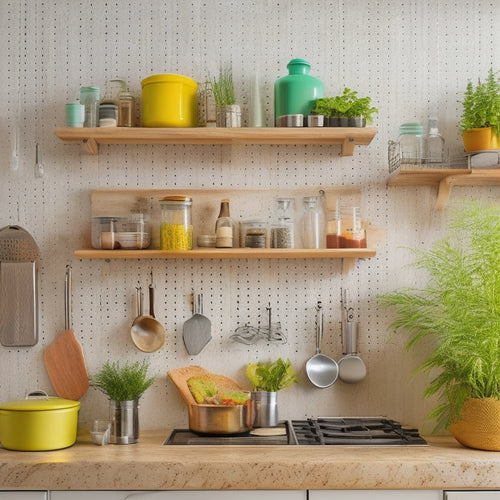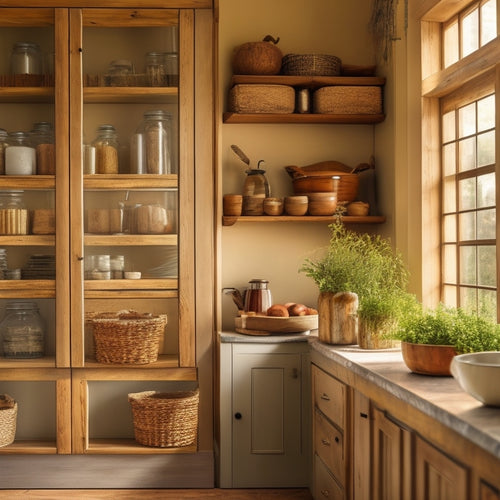
Enhance Kitchen Safety for Children's Well-being
Share
Enhancing kitchen safety is important for protecting children's well-being, as accidents, injuries, and foodborne illnesses can have long-term consequences on their health. Childproofing cabinets, using kid-friendly appliances, and supervising cooking are necessary steps to prevent harm. A strategic kitchen layout, safety latches, and locks can also reduce the risk of accidents. Additionally, practicing safe food handling, maintaining a clean kitchen, and creating a secure environment are key components of a safe kitchen. By implementing these measures, parents can greatly minimize the risks and create a safe haven for their children. Explore these essential components further to guarantee a safe kitchen for your little ones.
Key Takeaways
• Ensure childproofing of cabinets, drawers, and appliances to prevent access to hazardous materials and sharp objects.
• Supervise children while cooking and teach them safe food handling practices to reduce the risk of accidents and foodborne illnesses.
• Organize the kitchen layout strategically to prevent tripping hazards and ensure a clear path for children to move around safely.
• Install safety features such as anti-scald devices in sinks and bathtubs, and secure heavy furniture and appliances to prevent tip-overs.
• Promote cleanliness and sanitation in the kitchen by assigning designated areas for food storage and preparation, and sanitizing surfaces regularly.
Kitchen Safety Essentials for Kids
As caregivers, it is vital to establish a safe kitchen environment for children, where they can learn and participate in meal preparation while minimizing the risk of accidents and foodborne illnesses.
Childproofing cabinets and installing safety utensils can prevent access to hazardous materials and sharp objects. Kid-friendly appliances with safety features can also reduce the risk of accidents.
Cooking supervision is essential, as it allows caregivers to monitor children's activities and intervene when necessary.
Preventing Accidents and Injuries
A well-organized kitchen layout and strategically positioned safety features can significantly reduce the risk of accidents and injuries, allowing children to explore and learn in a secure environment.
Childproofing cabinets and drawers is essential to prevent access to sharp objects, hot surfaces, and hazardous substances. Installing safety latches and locks can help prevent unwanted openings.
Additionally, avoiding burns is essential, and this can be achieved by keeping hot surfaces and appliances out of reach, using oven mitts, and supervising children while cooking.
Safe Food Handling Practices
Proper food handling and storage are vital in preventing foodborne illnesses, which can have devastating consequences, especially for young children. To ensure safe food handling practices, caregivers must prioritize effective handwashing before handling food and supervise children to do the same before mealtimes.
Additionally, proper food storage is essential, with perishable foods stored in covered containers at 40°F or lower and hot foods kept at 140°F or higher until ready to be eaten. By following these guidelines, the risk of foodborne illnesses can be greatly reduced, creating a safer kitchen environment for children.
Maintaining a Clean Kitchen
Cleanliness is an essential component of kitchen safety, and maintaining a clean kitchen environment is fundamental to preventing the spread of harmful bacteria and germs that can cause foodborne illnesses in children.
A well-organized kitchen is pivotal in promoting cleanliness, as cluttered spaces can harbor germs and bacteria. Implementing effective kitchen organization strategies, such as assigning designated areas for food storage and preparation, can notably reduce the risk of contamination.
Additionally, sanitizing surfaces regularly is crucial in eliminating germs and bacteria. Focus on high-touch areas like countertops, sinks, and faucets, and use a mixture of soap and warm water to sanitize these surfaces.
Creating a Secure Environment
Vigilance is paramount in creating a secure environment where children can explore and learn about food preparation without being exposed to unnecessary risks. Childproofing cabinets and installing safety locks on hazardous areas can notably reduce the risk of accidents.
Make sure that sharp objects, heavy appliances, and hot surfaces are out of reach from curious hands. Secure heavy furniture and appliances to prevent tip-overs, and install anti-scald devices in sinks and bathtubs.
Additionally, store hazardous substances, such as cleaning supplies and medications, in inaccessible areas. By taking these measures, you can create a safe and secure environment where children can learn and grow without compromising their well-being.
Frequently Asked Questions
How Often Should Caregivers Check Refrigerator Temperature to Ensure Food Safety?
'Frequent fridge checks are fundamental to food safety. Caregivers should regularly review refrigerator temperature, ideally daily, to confirm it stays below 40°F, maintaining a safe haven for stored food and guaranteeing child well-being.'
Are There Any Specific Cleaning Products Recommended for Kitchen Surfaces?
When selecting cleaning products for kitchen surfaces, prioritize child-friendly disinfectants and non-toxic surface cleaners to guarantee a safe environment for children. Opt for gentle, eco-friendly alternatives that effectively combat germs and bacteria without exposing children to harsh chemicals.
Can Children Help With Meal Prep, and if So, How Can They Participate Safely?
Children can participate in meal prep with proper supervision, teaching cooking skills, and emphasizing safety protocols, such as knife safety and measuring ingredients accurately, to foster independence and responsibility in the kitchen.
What Is the Recommended Method for Storing Leftovers to Prevent Spoilage?
According to the USDA, 30-40% of food in the US goes uneaten, resulting in significant waste. To prevent spoilage, store leftovers in airtight, labeled containers at 40°F or below within two hours of cooking, and consume within 3-4 days, promoting leftover organization and preventing waste.
Are There Any Specific Kitchen Safety Rules That Should Be Posted Visibly?
To guarantee a secure kitchen environment, post visible safety signage outlining essential rules, such as handwashing protocols, food storage guidelines, and hazardous product handling, to promote awareness and adherence to important kitchen safety practices.
Related Posts
-

Stylish Pegboard Storage for Open Kitchen Concepts
Stylish pegboard storage can completely enhance your open kitchen concept, merging practicality with contemporary fla...
-

Tiered Kitchen Rack Ideas for Small Spaces
Tiered kitchen racks are perfect for maximizing small spaces while adding style and functionality. Install wall-mount...
-

Freestanding Pantry Units for Farmhouse Kitchen Style
Freestanding pantry units perfectly blend beauty and function in your farmhouse kitchen. They maximize storage while ...


